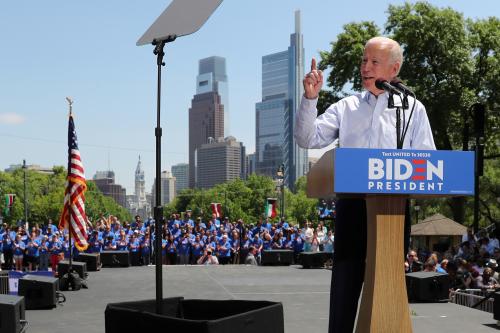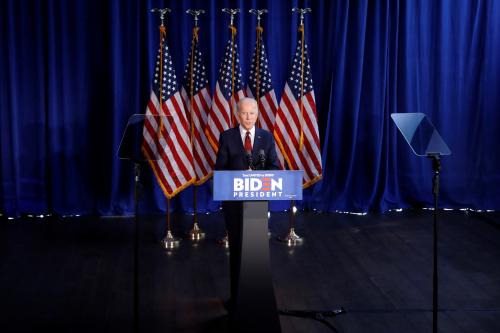As we reach the end of this early chapter—these first 100 days—of the new Biden administration, much can be said about the dramatically different world view of this president when compared to President Trump and his “America First” mantra. In many ways, the early actions of the Biden-Harris White House resemble the forward-leaning, solution-focused optimism of the early Obama administration, but with a far greater emphasis on the connectivity between U.S. foreign affairs and American domestic politics. Indeed, President Biden’s central “Foreign Policy for the Middle Class” argument, which places domestic economic renewal as the top priority of America’s actions abroad, speaks to this viewpoint directly. It also highlights the manner in which domestic political considerations and opinions drive policy objectives for President Biden—another key theme thus far.
A Biden Doctrine?
An emerging “Biden doctrine” can be found in the release of its “Interim National Security Strategic Guidance (iNSS)”—a precursor document to the official National Security Strategy (NSS)—only two months after taking office. No document to date better encapsulates President Biden’s world view and the likely trajectory of U.S. foreign policy. Indeed, the document seeks to foretell the administration’s strategic vision, but two quotes stand out: 1) “In advancing America’s interests globally, we will make smart and disciplined choices regarding our national defense and the responsible use of our military, while elevating diplomacy as our tool of first resort,” and 2) “At a time of multiple, intersecting crises, we must recognize that our strength abroad requires the United States to build back better at home.”
In so many ways, these comments define the still-nascent “Biden doctrine.” The document also speaks at length about the Biden administration’s desire to reinvigorate American leadership within international institutions, to join with fellow allies and partners in strengthening our shared values all around the world, and to confront the “revolution in technology that poses both peril and promise.”
On this latter point about emerging technology, which includes artificial intelligence, quantum computing, biotechnology, advanced robotics, and more, the strategic need for American leadership is truly pressing. New technologies are in many ways both the key to and the vital intersection of healing our society and building back better, ensuring America’s role as a geopolitical leader, and the coalescing of democratic nations around a common purpose. Especially given China’s surging technology sector, the long-term strategic viability of the United States and our allies may lie in our leadership around the creation and deployment, but also the character, of these technologies. New and emerging technologies are likely to be the driving force of the 21st century at multiple levels, and the inclusion of this issue in the iNSS is essential.
Though still early, the Biden administration has moved decisively on several fronts promised during the campaign and spelled out in the interim guidance: resuming negotiations with Iran, rejoining of the Paris Climate Agreement, and expressing the President’s outspoken support of NATO. Associated with these moves, the Biden administration has rightly said that it desires a review of many existing U.S. policies at home and abroad. Friend and foe alike are eagerly awaiting the outcomes of these reviews, which for some seem to be taking an eternity.
Implementing policy
In his first 100 days Biden has not only begun to sketch out a coherent doctrine but he has appointed leaders who are aligned with his perspectives and have significant foreign policy experience both in Washington and abroad, and across multiple prior administrations. From Secretary of State Tony Blinken and Secretary of Defense Lloyd Austin to Director of National Intelligence Avril Haines, Central Intelligence Agency Director Bill Burns, United Nations Ambassador Linda Thomas-Greenfield, and likely USAID Administrator Samantha Power, theirs is a perspective tempered by decades of lived experience, public service in support of the American people, and exposure to prior presidential leadership and policy perspectives. And importantly, the department and agency teams these individuals have begun to bring on board have thus far showcased a similar level of expertise. This latter point is essential, as these are the individuals placed in charge of actually implementing major U.S. policy decisions.
The character of American leadership
In addition to these important early observations, one additional question is central to the Biden administration’s world view, which has been voiced by a number of foreign officials in recent months: Is President Biden a return to the traditional “rule” for American leadership, or are he and his administration now the “exception to the new rule” following four years of “America First” foreign policy, ultra-nationalism, and an overall doctrine of transactional U.S. engagement? The definitive answer to that question will of course be found in the 2024 U.S. presidential election. Until that time however, the Biden administration will almost certainly do everything in its power to strengthen multilateral relationships and international institutions, and to, at minimum, reassure our allies that America leadership is back on the world stage. This same logic applies to their urgency to “prove” President Biden’s legitimacy at home, too, via a foreign policy focused on domestic American prosperity. This White House has a truly pressing need to prove wrong the naysayers at home and abroad; America’s ability to operate as a credible global actor depends on it.
Only time will tell if the palpable uncertainty, trending to genuine concern, amongst U.S. allies is well-placed. This dynamic is a pall hanging over the Biden administration. Such efforts will also be central to President Biden’s overall approach to the world as well as his policy calculations when engaging abroad. Here, winning “hearts and minds” is as important internationally as it is at home (i.e., the previously mentioned “Foreign Policy for the Middle Class” concept). The desire to bring together the world’s democracies for a “Summit for Democracy” is grounded in this priority, too. Only together can democratic states strengthen their shared commitments and values and push back against the global rise of authoritarianism and radicalism.
The global race to develop new and emerging technologies is also crucial to this point. Over the mid- to long-term, no one nation will be able to compete against China in the creation and deployment of technology. Beyond the literal strategic implications of such a reality, it also risks the slow evolution of a world bifurcated not only by both the technologies we use, but also the values that informed their creation and ultimately their employment. From advanced surveillance networks to autonomous weapons systems, there are lines that global democracies will likely never cross, but which our adversaries will assuredly ignore.
So, what then of the days ahead?
From the continuing, though lessening, devastation of the COVID-19 pandemic; a teetering economy characterized by staggering income inequality; the looming threat of climate change; pervasive scourge of systemic racism; and the steady rise of authoritarian leaders inimical to our values, few if any other administrations have inherited more challenges on its first day in office. President Biden has shown a desire to frame U.S. foreign policy objectives around fair competition and collaboration, especially around issues like climate change, COVID-19, or even the U.S.-China relationship. The aforementioned democracy summit, which is aligned with this latter approach, would bring together a global, values-based community of democracies united by system of government, the interrelationships of their economies and commitment to free and fair trade, the aggregation of their technologies dedicated to the public good, and more
Though none can truly know the full measure of tomorrow’s challenges, we can safely assume this solution-focused, multilateral world view will persist across the trying months and years ahead.








Commentary
The first 100 days: What does President Biden’s approach to the world look like so far?
April 23, 2021